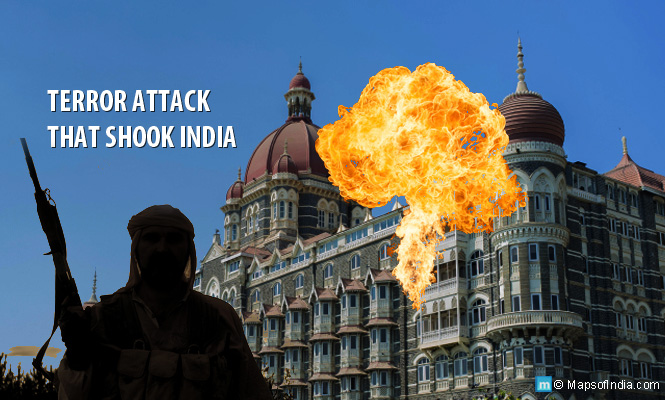Here is the list of terror attacks that shook India.
26/11 Terror Attack
The worst terror attack ever suffered by India was on the fateful days of November 2008 when for four days, 10 terrorists held the commercial capital of India to ransom. The carnage started on the 26th when they entered the country through sea and started a killing spree unlike anything seen before. There was plenty of gunfire and a few bomb blasts as well. The terrorists captured important places such as Nariman House, Hotel Oberoi Trident and Hotel Taj. They also targeted other crucial locations in Mumbai such as Chhatrapati Shivaji Terminus, Metro Cinema, Leopold Café, the office of Times of India, and Cama Hospital – all important places in the cityscape. Incidentally, most of these places were frequented by foreigners who were also on the radar of the terrorists.
Only one of the terrorists – Ajmal Kasab – was caught alive, while the others were killed in encounters with NSG commandos and police officers. Without a shadow of a doubt, this is the worst terror attack that India has ever seen. It was conceived by Hafiz Saeed, a well-known anti-Indian militant based in Pakistan and the head of Lashkar-e-Taiba, whose members executed the whole attack. In all, 166 lives were lost and 293 people were injured. This count includes Indian civilians, police officers and security personnel along with foreign nationals.
Mumbai Serial Bomb Blasts
From the looks of it, Mumbai has always been high on the wish list of criminal elements such as gangsters and terrorists. On 12th March 1993, the city was rocked by a series of bomb blasts. The tremors of the blast could be felt around India. This planned sequence of blasts is still regarded as the deadliest of its brethren in India. Dawood Ibrahim, who ran the international syndicate of organised crime named D-Company, conducted the attacks. The explosions took place at the following locations:
- Fisherman’s Colony in Mahim Causeway
- Sahar Airport
- Zaveri Bazaar
- Air India Building
- Plaza Cinema
- Hotel Juhu Centaur
- Century Bazaar
- Worli
- Katha Bazaar
- Bombay Stock Exchange Building
- Hotel Sea Rock
- Passport Office
It is believed that a number of smugglers – from India and Pakistan – contributed financially to this terror enterprise. India has also accused Inter Services Intelligence, the intelligence agency of Pakistan, of having masterminded the attacks. Pakistan and the UAE were supposedly the locations where the terrorists were recruited and then trained. In all, 257 people lost their lives and 713 were injured.
Akshardham Temple Attack
On 24th September 2002, Akshardham Temple in Ahmedabad came under attack of Ashraf Ali Mohammed Farooq and Murtaza Hafiz Yasin. They were members of terror outfits: Jaish-e-Mohammed and Lashkar-e-Taiba. On that day, they entered the temple at around 3 PM and had weapons such as hand grenades and automatic weapons. Soon, indiscriminate firing started. However, NSG commandos were able to kill both of them by night. The authorities found a letter later on that stated this attack was a sort of retribution for the Gujarat riots of 2002. Around 80 people were injured and 31 people lost their lives in the incident.
Delhi Serial Bomb Blast
On 29th October 2005, which was a couple of days prior to Diwali that year, three bomb blasts rocked the national capital. The Islamic Revolutionary Front, a terrorist organization based out of Pakistan, conducted the blasts. A couple of blasts took place at Paharganj and Sarojini Nagar, the main market areas in the city. The third blast happened inside a bus that was stationed in Govindpuri. In case of the bus, it was the awareness of the passengers and conductor that saved the day somewhat. Immediately after seeing a suspicious bag, they started to unload the bus and this minimised the blast’s impact. However, the situation was rather grave in the marketplaces since it was the time of Dhanteras and there were too many people over there; 63 people passed away in the blasts and 210 people were injured in the same.
Mumbai Train Blast
On 11th July 2006, seven bomb blasts happened in local trains of Mumbai. The explosives had been planted in the first class coaches of the trains inside pressure cookers. Investigation into the blasts found out that Indian Mujahideen, a banned terror outfit, was responsible for the blasts. The explosions happened either in or near the following suburban railway stations:
- Matunga Road
- Jogeshwari
- Mahim
- Bhayandar
- Bandra
- Borivali
- Khar Road
These were the deadliest attacks in Mumbai after the blasts of 1993. They claimed 210 lives and almost 715 people were injured in the same.
Jaipur Blasts
On 13th May 2008, Jaipur was hit by a sequence of nine blasts that took place in 15 minutes. The authorities were able to find the 10th bomb and disarmed it. This was an eye-opener of sorts since this city never seemed to be on the terror radar before this. Jaipur also happens to be one of the major tourist attractions in the country. In fact, one bomb exploded in the vicinity of the Hawa Mahal. Police investigations revealed possible involvement of several Islamic militant outfits such as Harkat-ul-Jihad-al-Islami, Lashkar-e-Taiba, and the Student’s Islamic Movement of India. Authorities were also of the opinion that Al-Qaeda may have been involved in the same. The bomb blasts happened at six locations:
- Bari Choupar
- Tripolia Bazar
- Manak Chowk Police Station Area
- Choti Choupar
- Johari Bazar
- Kotwali Area
The blasts were coordinated in such a manner that whenever people ran to a safe place there was an explosion over there – the terrorists had proper idea as to where people would seek refuge in case of an explosion; 63 people died in the blasts and 210 were injured.
Assam Bombings
These serial blasts took place on 30th October 2008 and are also regarded as one of the most damaging of their kind to have taken place in India. Guwahati, the capital of Assam, was the target this time around. There were 18 blasts in different parts of the city leading to death of approximately 81 people; 470 people were injured in the same. The major areas affected in the blasts were Barpeta Road, Kokrajhar, and Bongaigaon. The main market in the city was also targeted and that too when it was heavily crowded. No group came forward to take responsibility for the same, but the authorities felt that it was the handiwork of the National Democratic Front of Bodoland (NDFB). In fact, as told to the-then Indian Prime Minister – Manmohan Singh – the army had got hold of a message that asked Guwahati to be attacked. It had come from Kolkata. The authorities tried for six months to prevent the attack, but their efforts were unsuccessful in the end.
Indian Parliament Attack
The Indian Parliament is supposed to be the safest building in the whole country. However, it came under attack on 13th December 2001 by five terrorists belonging to Jaish-e-Mohammad and Lashkar-e-Taiba. The security forces were able to prevent any major damage by killing the terrorists before they could get into the main building. However, this hardly takes away from the fact that they were able to get as far as they eventually did. It is something that can never be erased from the pages of history. They used false stickers of the Home Ministry and Parliament to gain entry. However, when they got close to the Vice President’s convoy, they got down from their cars and started to fire. The whole exchange lasted for several hours. At that time, there were at least 100 political figures in the parliament including Harin Pathak, the-then Minister of State for Defence, and LK Advani. Three parliament staff members and six police officers died in the incident.
Coimbatore Bombings
On Valentine’s Day 1998, an Islamist fundamentalist outfit named Al Ummah carried out 12 bomb blasts at 11 separate locations in the South Indian city Coimbatore. LK Advani, who at that time was in the city in order to attend an election meeting, was the primary target of the attack. Most of the blasts happened at the areas that were mostly inhabited by Hindus and they featured predominantly among the victims. The terrorists also wished to harmonious situation in the city as well as the commercial progress it had achieved; 60 people lost their lives in the bombing and at least 200 were injured.
Jammu and Kashmir Legislative Assembly Attack
On the first day of October 2001, a number of Jaish-e-Mohammad terrorists attacked the legislative assembly of Jammu and Kashmir. Three suicide bombers and a car bomb were used to carry out the operation at the Legislative Assembly Complex in Srinagar. The three suicide bombers and 38 others lost their lives because of the attack.
Also Explore :
- Headley’s Deposition in 26/11 Mumbai Terror Attack : Interesting Facts & Diclosures
- 26/11 Mumbai Terror Attack: Details Review, Reasons & Facts
- The Pathankot Terror Attack: An Analysis
- Top 10 Terror Attacks in India
- India’s 10 Most Wanted Men
- Most Active Militant Groups in India
- Terror of Drones – Deadly weapon in hands of Terrorists
- How is India preparing to counter the ISIS threat?
- Terror Attacks: Has Jihadi Movement Come to Northeast?
- Is ISIS a threat to India?
- Why do our youth want to join ISIS?
- Z Plus Security
- Cross border firing Issue between India and Pakistan
- West Bengal – Why It’s Called A Safe Haven For Terrorists?
- Terrorist Attacks in India – New use of cycle
- Hindu-Muslim Relationship





